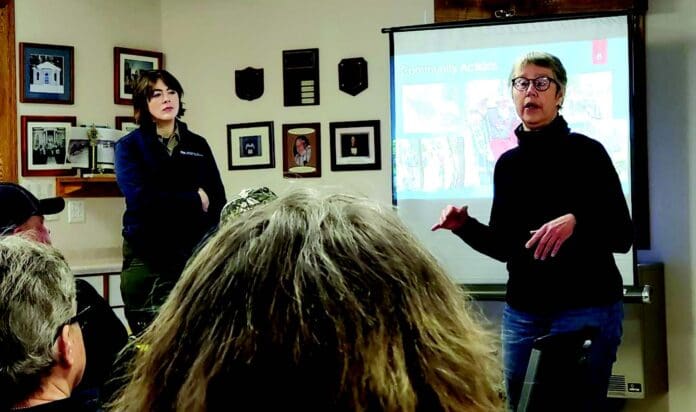After attending the Firewise Demonstration at Ault Townhall on Saturday, March 16th, I talked to someone over the phone who was at the airport to pick someone else up. They had a long wait in front of them, so it’s a good thing I called. There were a lot of interesting things I learned about making my home and property more resilient to wildfires and I wanted to tell someone about them. It sparked a lot of good conversation and I hope it helped make the time go by faster.
Community members, as well as members of the Brimson Area Volunteer Fire Department (BAVFD), and others gathered in Brimson to talk about a very real and present fire danger in the area.
“Brimson is at risk and all the stakeholders know that. The Forest Service, the DNR, and everybody’s got their eye on Brimson because we haven’t burned in ages and the fuels are just building up every year,” said Diane Dickey, BAVFD Fire Chief.
Gloria Erickson, who works for a non-profit organization that contracts with St. Louis County, is the Firewise Coordinator and led the demonstration along with Laura Murphy. A member of the MN DNR, Murphy is the Northeast Region’s Firewise Specialist.
When the group was prompted to think of things fire is good for, I’m happy to report that roasted marshmallows made the list before wood stoves. Priorities are straight around here.
The exercise was meant to point out the fact that fire isn’t necessarily a bad thing. Boreal forest biomes rely on fire to regenerate. Low-intensity and prescribed fire have been used for things like getting rid of weeds, eliminating ticks, and to encourage new growth of pines and blueberries. It’s not a new concept. Erickson spoke of the Anishinaabe who used controlled fire to keep the land healthy.
But a lot of the land around here isn’t as healthy as it could be. Perceived risk of fire in both St. Louis County and Lake County is high. “Right now, the fuel load out there is huge,” said Erickson.
The threat to the safety of the people who have chosen to live out in the woods and the homes we live in can be mitigated by building a “Fire Adapted Community.” Some actions a community can take in the right direction are to work with contractors to remove dead and dying trees from properties, build co-ops of neighbors who help each other cut up wood or help to burn it, and chipping events where participants are even welcome to take some of the wood chips home for their gardens. Getting people together who have chainsaws or equipment or even land where debris can be moved to help make the community more resilient.
Individual efforts are required, as well. There was discussion about fire signs and the need for them to be clear for firefighters to see. This means they need to be reflective on both sides, perpendicular to the road, and clear of vegetation. The sign should be at least 4 feet up from the ground. These signs are available to purchase for $35 through the county.
Something that really stuck with me is the portion of the demonstration that spoke to access for the firefighters and their firetrucks. As we are still developing our property, we have a plan to make the driveway loop around for easier access. This is a good plan. Fire trucks need a lot of room to turn around. In an emergency where other homes may also be in danger, it’s crucial that the truck is able to make it in and out easily. A solid surface is best, when it’s possible. It’s also helpful to clear the driveway both fourteen feet wide and high so they can fit through.
There is also much that can be done around our homes and yards that can help mitigate any damage a fire may cause. The Firewise demonstration broke properties out into zones. The immediate zone referred to anything within five feet of the structure. Nothing flammable should be stored here. No firewood piles, no propane tanks on a grill, no pine needles, or dead plants. Wood mulch and tree limbs should also be removed.
The intermediate zone, five to thirty feet away from the structure, should be free of balsam that is six inches or less in diameter. “Dead or alive,” said Erickson, explaining that balsam is the most flammable of trees. I believe it. We’ve burned enough off of our property that seeing the abundance of dead balsam throughout our area makes me nervous. It’s easy to see how it could all go “poof” very quickly. It was also recommended to clean any vegetation away from propane tanks. Did you know that the release valve of a propane tank can shoot fire out the top if it has heated up too hot in a wildfire? I didn’t. Now I know to remove any limbs hanging over my tank!
In the extended zone, thirty to one hundred feet, anything “dead and down” should be removed. Large logs can be left as long as there is no space between the log and the ground. Limbs should be removed. This can help to prevent surface fires. Removing underbrush is also recommended as when it starts to burn it can act as a ladder to start a crown fire.
The attendees asked questions about brush piles and the resources available. There were questions about how state and county land is managed. There were discussions around sprinkler systems and the cost, maintenance, and effectiveness of them. Also discussed were local events where chipping services were provided and places to drop off debris.
They were advised of resources available in the communities, including a Firewise evaluation that is free to the public. These evaluations include a visit to your home to provide any guidance to make the property more fire resilient.
“The more we get the word out about how to take care of your property and take responsibility the better off we’re all going to be. It’s a community effort,” said Dickey.
I learned a lot more than all I’ve mentioned here, and I went home and really evaluated what I may be able to do around the property to make it safer for me and my neighbors. If you would like more information on Firewise, visit dnr.state.mn.us/firewise. You can also contact Gloria Erickson, St. Louis County Firewise Coordinator at 218-365-0878. Lake County’s Firewise Coordinator is Aaron Molin-King who can be reached at 651-387-1770. To reach Laura Murphy dial 218-878- 5646. If you are interested in volunteering for BAVFD, please reach out to Diane Dickey at 218-269-6160.






